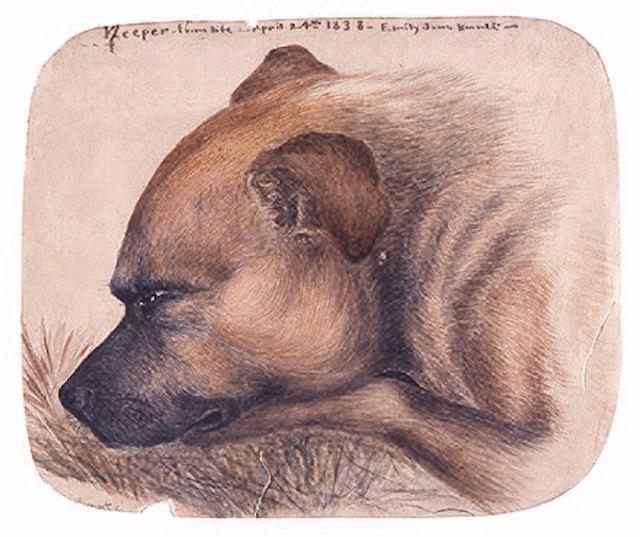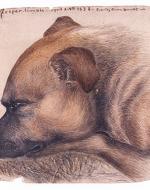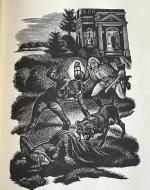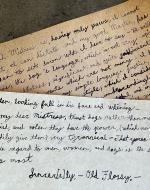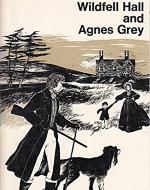Created by Katie Locke on Tue, 11/15/2022 - 11:36
Description:
Dogs were quite prominent in the Brontë sisters' lives. They were the subjects of drawings by Charlotte, Emily, and Anne and companions to Emily and Anne. Emily believed dogs were superior to humans, Anne put the needs of animals over her own, and Charlotte deeply cared for her siblings’ dogs after Emily and Anne passed away. While Emily and Anne captured the essence of their dogs in their works, dogs eventually found a voice when their father wrote a letter to Charlotte from the perspective of Anne’s dog, Flossy. Emily and Anne display their experiences and attitudes towards dogs in their novels, respectively, Wuthering Heights (1847) and The Tenant of Wildfell Hall (1848). In these works, they use the treatment of animals to demonstrate character and present dogs that reflect the personalities of their own beloved pets. If a character treats an animal cruelly or kindly, it indicates their owners' harshness or kindness. Care for animals thus resonates in Emily's and Anne's lives and fiction.
Emily Brontë, watercolor of Keeper, 1838, Wikipedia. Keeper was Emily’s beloved and loyal bull terrier. Emily did not have many close human friends, but she had a cherished bond with Keeper. He stayed by her side during her walks, lay next to her when she read, and, despite his large size, would do his best to fit himself on her lap when she sat down. Despite this attachment, Keeper could be quite intimidating. However, Emily matched his ferocity. On one occasion, Keeper was fighting another powerful dog in the street, and men were afraid to intervene. Emily got a pepper box, grabbed Keeper, sprinkled pepper on both dogs’ noses, and used the opportunity to take Keeper inside, leaving the men astonished. Emily believed dogs were selfish, and she was aware that they would fight for dominance if they deemed it necessary. However, dogs were more honest in displaying these traits, and Emily, therefore, considered dogs to be superior to humans.
Emily’ demonstrates her love for Keeper through the details of this illustration. Emily used several shades of brown to depict Keeper, trying to paint an accurate picture. Although she included realistic grass in the watercolor, she did not present a detailed background and instead focused on Keeper. He is resting and peaceful, showing a side of him that only Emily saw. Aunt Branwell and Tabby Aykroyd, the famiily housekeeper, feared him, and Keeper would knock Charlotte out of the way to try and sit on Emily’s lap. Keeper had a heavy-metal collar, but Emily did not paint him with one. Drawing him without a collar could represent Emily’s view that dogs are equal if not superior to humans.
Fritz Eichenberg, woodcut illustration in Wuthering Heights, by Emily Brontë (1847), 1943 Random House edition, personal collection of Catherine Golden. Eichenberg’s woodcut illustration depicts a scene from Wuthering Heights where Catherine is attacked by the Linton’s guard dog, Skulker, after she and Heathcliff are spying on the Linton family. Eichenberg convincingly portrays the vicious traits of dogs in his woodcut illustration of Skulker biting Catherine Earnshaw's ankle when she spies on the Lintons. Eichenberg gives Skulker a spiked collar, which is more unsettling than a common leather one or even a heavy-metal one like the one Emily's Keeper wore in real life. Skulker is being held back from further attack. The man holding onto him is also unsuccessfully attempting to pry him off Catherine. Skulker looks determined not to let Catherine’s ankle go, as his eyes and head are focused on her, his feet are firmly planted on the ground, and his tail is sticking straight up in the air. Emily’s diction in the scene describes a bloodthirsty animal, as Skulker must be violently pulled off Catherine. However, once Catherine is taken inside and cared for, her dynamic with Skulker completely changes. She sits by the fire with him, gives him part of her food, and is able to pinch his nose with no repercussions.
This interaction is similar to Keeper and Emily’s relationship. Emily gained Keeper’s respect in a fearless and brutal act. Keeper often napped on the sisters' beds, which upset their servant, Tabby. However, she was too scared to do anything, as Keeper was known for lunging at a person’s throat when they tried to scold him. If Keeper continued to lay on the beds, he would be banished from the house, so Emily took it upon herself to make him listen. She grabbed the large dog, cornered him, and beat him until he was nearly blind due to the swelling. Afterwards, she tended to his wounds. After Emily was violent towards Keeper, she earned his loyalty. In the Wuthering Heights scene, Skulker is violent towards Catherine, who ends up respecting him and enjoying his company. Possibly, Keeper's fight with another dog requiring Emily's intervention inspired this scene in Wuthering Heights. In both situations, the dogs had to be violently pulled away from their target. Another event that could have impacted this scene was when Emily was bitten by a sick dog after trying to give it water. Rather than panic, she cauterized her own wound by taking a burning hot Italian iron out of the fire and holding it to the bite. Emily’s calm actions in a time of chaos as well as her fierceness are qualities she displays in Wuthering Heights through Heathcliff’s brutal plans and other violent actions throughout the novel.
Charlotte Brontë, painting of Flossy, n.d., The Victorian Web. Anne’s spaniel, Flossy, was quite different from Keeper. Flossy was more of an upper-class name, and spaniels were breeds that the gentry preferred. Spaniels were known for being generally blameless creatures. Charlotte's painting of Flossy makes him come alive. Her illustration captures a paused moment. Flossy and the bird he is chasing are both mid-movement. It is easy to imagine someone pressing a play button, allowing Flossy’s paws to hit the ground as he continues his chase while the bird soars away. Charlotte’s painting also emphasized realism. She paid close attention to Flossy’s fur. The texture and length of the fur on his body and tail differ, which is often seen in certain dog breeds. Additionally, the setting is quite realistic. It is not uncommon for a dog to be chasing a bird or another wild animal. The sisters most likely watched their dogs doing just that as they ran through the moors, which form the background of the image.
Anne clearly had a large amount of sympathy for animals, as shown through her love for Flossy beautifully drawn above as well as her treatment of dogs in The Tenant of Wildfell Hall and in her personal life. When she was in Scarborough, dying from tuberculosis, she rode in a cart pulled by a donkey. Instead of enjoying the ride, Anne worried that the speed the donkey was urged to go at would make it uncomfortable. Although she was weak from her illness, she took the reins herself and told the cart driver to treat the donkey well. Anne’s strong bond with her pet, Flossy, was also clear to Charlotte, who thought of Flossy when she visited Anne’s grave at Scarborough. Charlotte remarked that she had seen a dog run in the ocean and play in the waves and wondered what Flossy would think of it.
Reproduction of Patrick Brontë’s Letter From Flossy to Charlotte Brontë, 1853. In a letter written to Charlotte after Emily and Anne passed, the sisters’ father, Patrick Brontë, pretended to be Anne’s dog, Flossy. In the letter, “Flossy” explains that his Master, Patrick Brontë, is transcribing Flossy’s ideas, as Flossy cannot write for herself. Flossy has gotten older, and while he can no longer chase animals or chew bones, he has more time to watch humans interact. Flossy tells Charlotte how friends betray one another and concludes the letter stating that dogs should be trusted over men. At the time, Arthur Bell Nicholls, Patrick’s assistant curate, wanted to marry Charlotte. Patrick vehemently disapproved and was unafraid to show it, as he ended up not attending the wedding. As Flossy discourages trusting men in the letter, perhaps Patrick was trying to convince Charlotte not to marry Arthur. If she would not listen to her father, maybe she would listen to Flossy.
The sisters’ love of dogs was inherited from Patrick, who deeply cared for animals. When he was going to have a cataract operation that he might not survive, he was upset by the possibility of never being able to feel Keeper’s paws on his knees again. After Charlotte died, he got two more dogs, one he believed Charlotte liked.
Book cover of The Tenant of Wildfell Hall and Agnes Grey, by Anne Brontë (1847, 1848), 1980 Everyman paperback, published by Dutton, ABE Books. Anne portrays her sympahty for dogs in The Tenant of Wildfell Hall. Characteristics of Helen Graham’s past and present love interests, respectively Arthur Huntingdon and Gilbert Markham, emerge through their treatment of dogs. Arthur hits his dog, Dash, when Dash gleefully greets him. Arthur then calls to Dash, who, now scared, does not come. In response, Arthur throws a heavy book at the animal’s head. In contrast, Gilbert’s dog, Sancho, is Gilbert’s close companion. Gilbert treats Sancho carefully and with love, which shows his good character.
Sancho's presence on a 1980 Dutton book cover emphasizes Gilbert's kind characterization in the novel. Here Sancho is at Gilbert’s side. The two are unified, as they have similar posture, and their heads are titled the same way, both looking at Helen. The cover art provides an illustration of Sancho and Gilbert’s bond and, therefore, Gilbert’s positive character, especially when compared to Dash and Arthur’s relationship. Sancho's inclusion on the book cover illustrates how a dog is clearly Gilbert’s companion as well as the importance of dogs to the Brontës.

